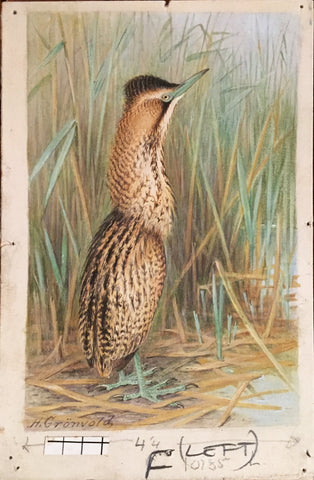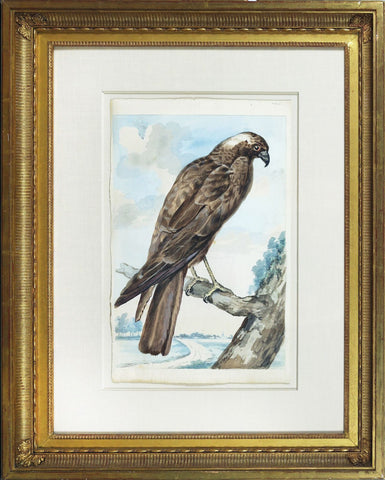
Henrik Grönvold (Danish, 1858 –1940), Botaurus Stellaris (Bittern)
Henrik Grönvold (Danish, 1858 –1940)
“Botaurus Stellaris (Bittern)”
Prepared for Plate XII W.H. Hudson and L. Gardiner, Rare, Vanishing and Lost British Birds (1923)
Pencil and watercolor heightened with gouache, some with touches of gum Arabic on card
Signed ‘H Gronvold’ l.l.
1922-1923
Paper size: 7 7/8 x 5 1/8 in.
Provenance: Anonymous sale; Christie’s, London, 17 March 1999, lot 149, private collector.
“This species, once called the Common Bittern, and found in all suitable localities in England, Scotland, and Ireland, was one of the most fascinating of the British birds on account of its solitary, mysterious habits, its strange, richly coloured and beautifully pencilled plumage, and that booming cry, once familiar in our land, that ‘shakes the sounding marsh.’ This ‘boom,’ which was uttered during the love season, is likened by those who have heard it to the deep-toned bellowing of a bull. People wondered how so vast a volume of sound could proceed from a bird of its size; and superstitious persons who dwelt commonly within hearing of it, attributed the sound to no Bittern, or bird, but to the demon or spirit of the desolate places of the earth. There is, said Robert Mudie, a ‘sublimity’ about the Bittern.
In Norfolk and Lincolnshire it was formerly most abundant, and Stevenson tells of marshmen who were not satisfied to sit down to their Sunday dinner without a roasted Bittern on the table. In 1830 the bird had already become comparatively rare, and the same writer says: ‘For at least fifteen or sixteen years, prior to 1866, I believe this species had altogether deserted us, but in the summer of 1866 the boom of the Bittern was again heard at Hoveton Broad.’ Two years later, in the summer of 1868, two eggs were found at Upton, and one young bird was taken.
No further record of their breeding existed until 1911, when a nest was discovered on one of the Norfolk Broads which is most zealously protected. But as a migrant, or straggler, the bird has continued to come to our shores, especially in severe winters, only to perish miserably at the hands of man. And always there have been great Bittern years, when they have come in numbers and have been found all over the land. It is on account of these movements that we may still hope to get it back in more than one district, if the shooting of every bird seen, by any lout with a gun, can be stopped. There is perhaps no rare species whose appearance in some part of England is more often recorded by an obituary notice in the newspapers. Occasionally a prosecution is taken in hand, usually through the efforts of the Society for the Protection of Birds; but with little or no effect, for no effect is possible under the present condition of things. We may cherish a hope of the establishment of new British breeding-places of the Bittern in some of the haunts of the old British race: but as long as the excuse avails that the strange visitor was shot in mistake for a Heron or a Duck, or as something unknown and therefore to be killed, any law is little likely to be observed. And as long as magistrates, though compelled by the evidence to impose a small fine, leave the skin with the man who killed it or bought its dead body, they maintain the hateful fallacy that the value of a rare bird lies in its skin and feathers, and that the collector is more to be considered than the bird life of the country. It is still true, as when these papers were written more than a quarter of a century ago, that a Bittern is no sooner seen than shot, when the event, together with the name of the local bird-stuffer, who receives the body to practise his beautiful art on, is chronicled in the newspapers. There the interest ends; since the dead Bittern, having lost its ‘sublimity’ with its life, is no longer an object that any rational being can take pleasure in contemplating.
Can nothing be done to stop the annual slaughter of such visitants as these? of which some few, I feel confident, under a protective system, would still pretty regularly remain to breed with us.
Thus wrote Henry Stevenson, author of the Birds of Norfolk , when near the end of his life. In the favoured county where he had always lived, he had witnessed the extermination of some beautiful and interesting species, and had observed that others were annually becoming scarcer; and his soul at length revolted against the senseless and hateful passion for killing every creature distinguished by its beauty, strangeness, or rarity. But he could do no more than ask, as so many others have asked during the last half-century, ‘Can nothing be done?’
‘This without doubt is that bird our common people call the Night-Raven, and have felt such a dread of, imagining its cry portends no less than their death, or the death of their near relations. For it flies in the night, answers their descriptions of being like a flagging collar, and hath such a kind of hooping cry as they talk of.’— Wilughby.
‘It is a remarkable fact that of the rare species recorded by Sir Thomas Browne as seen in Norfolk in 1671, but two, the Spoonbill and the Cormorant, had ceased to do so at the commencement of the present century. Whilst from this time we must date those agricultural changes which were destined to alter the general aspect of the county, it was not until within the last twenty-five or thirty years that these, combined with other causes, resulted in the extermination of so many resident species. Among our marsh breeders the curtailment and in some places total reclamation of their haunts through drainage has been the main cause of extinction; but the increasing demand of collectors of late years, and the high prices given for both birds and eggs, the cheapness of fire-arms and rapid transit by rail to all parts of the country, offering every facility—have conduced not a little to the same end, and former residents, receiving additions to their numbers in autumn and winter, can be described now only as migrants, perhaps occasionally remaining to breed. As such the Bittern alone holds its place amongst the birds of Norfolk at the present time, although entered as common in Hunt’s list in 1829.’— Stevenson’s Birds of Norfolk.
In 1837 about a dozen passed through the hands of Mr. Henry Chapman, bird-stuffer, of York, and in 1831 twenty-five specimens were brought to Mr. Hugh Reid of Doncaster. Fifteen were shot near that town in one year. Upwards of sixty were ascertained by Mr. Arthur Strickland to have been killed in the county in that year, in which they were unusually abundant all over England.— Morris’s British Birds.
In the first half of the last century it nested in many parts of the British Isles, and, in spite of persecution, survived in Norfolk until the end of the sixties. After 1868, except for some young birds which had evidently been hatched in the neighbourhood, reported in 1886, it was extinct as a breeding species until 1911, when Miss Turner and James Vincent located a nest. How many pairs managed to rear young in the next few years is uncertain, but in 1918 and 1919 a number of broods were safely reared. Collectors and not drainage were responsible for the loss of the Bittern; when under protection it found a safe area it quickly increased—yet outside strictly preserved districts ruthless shooting of the Bittern continues.— Coward’s Birds of the British Isles.
Witherby’s Handbook states that at least twelve pairs were breeding in 1920.—Vol. II. 220.”
HENRIK GRÖNVOLD (DANISH, 1858 –1940)
Henrik Grönvold studied drawing in Copenhagen and worked first as a draughtsman of the Royal Danish Army’s artillery and an illustrator at the Biological Research Station of Copenhagen. In 1892, Grönvold left Denmark for London, employed at the Natural History Museum preparing anatomical specimens. There he became a skilled taxidermist and established a reputation as an artist. He was employed at the Museum until 1895 when he accompanied William Ogilvie-Grant on an expedition to the Salvage Islands. After this expedition, Grönvold worked at the Museum in an unofficial capacity as an artist for decades and only left London to attend an ornithological congress in Berlin.
Grönvold’s illustrations mainly appeared in scientific periodicals such as the Proceedings and Transactions of the Zoological Society, The Ibis, and the Avicultural Magazine. In these publications, he drew plates for William Ogilvie-Grant, George Albert Boulenger, and Michael Rogers Oldfield Thomas, among others. Grönvold also completed numerous plates for Walter Rothschild, many of which appeared in Rothschild’s journal Novitates Zoologicae. Grönvold mostly illustrated birds and eggs, rare and newly discovered species from many parts of the world, and mostly worked in lithographs.
Among the books, Grönvold illustrated is George Shelley’s Birds of Africa, which contained 57 plates, many of which had not been illustrated before. He illustrated W. L. Buller’s books on the birds of New Zealand, Brabourne’s Birds of South America, Henry Eliot Howard’s The British Warblers (1907–14), Charles William Beebe’s A Monograph of the Pheasants (1918–22), and Herbert Christopher Robinson’s The Birds of the Malay Peninsula (1929–76). He completed 600 hand-colored plates for twelve volumes of The Birds of Australia (1910–27) by Gregory Macalister Mathews. Grönvold subsequently provided numerous illustrations for Mathews’ The Birds of Norfolk and Lord Howe Islands … (1928) and A Supplement to The Birds of Norfolk and Lord Howe Islands … (1936).
ORIGINAL WATERCOLORS FOR RARE, VANISHING
AND LOST BRITISH BIRDS
by Henrik Grönvold for William Henry Hudson
William Henry Hudson (1841-1922) was a naturalist, author, and staunch advocate for avian preservation and conservancy. Hudson’s lifelong commitment to protecting the environment stemmed from his youth in Argentina, where he marveled at the beauty of nature, spending endless hours watching the drama of forest and field unfold before him. This idyllic upbringing was beautifully penned in the artist’s work Far Away and Long Ago (1918), which remains a cult favorite amongst many novelists, including Ernest Hemingway, who wrote that Hudson’s book was a must-read for any young writer.
Hudson gravitated to studying birds, which guided his life’s work as an ornithologist and author of numerous tomes on the subject. When he settled in England in 1874, he joined the numerous societies for naturalists of the period and became a founding member of the Royal Society to protect birds.
In 1894, W.H. Hudson produced a leaflet titled Lost British Birds produced for Society for the Protection of Birds. Its purpose was to shed light on thirteen “lost” birds which he defined as those “which no longer breed in this country and visit our shores only as rare stragglers, or, bi-annually, in their migrations to and from their breeding areas on the continent Europe,” to concretely show the effect of industrialism, game hunting, and fashion on the sustainability of certain bird species. This pamphlet was illustrated with 15 rudimentary black and white line drawings by A.D. McCormick. Almost immediately after producing his brochure, Hudson began to collect notes for a future publication that would elaborate upon and update facts on endangered and extinct bird species.
Hudson spent the nineteen-teens and early twenties preparing his next publication. When his notes were organized, and he tapped the celebrated ornithological painter Henrik Grönvold (1858-1940) to produce a sophisticated full-color composition for each bird he intended to discuss at length. However, Hudson suddenly died in 1922 before the publication could come to fruition. Hudson’s colleague, Linda Gardiner, pushed the project forward to see it through in 1923.
Please feel free to contact us with questions by phone at 215.735.8811,
or by email at loricohen@aradergalleries.
We Also Recommend





